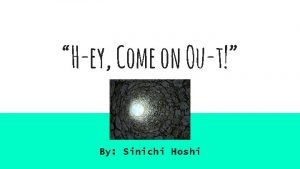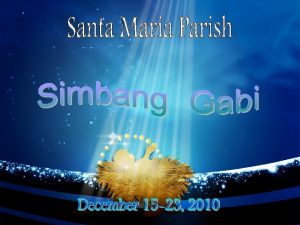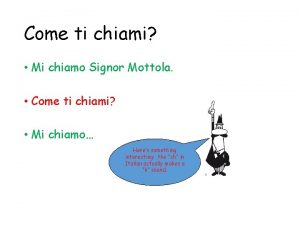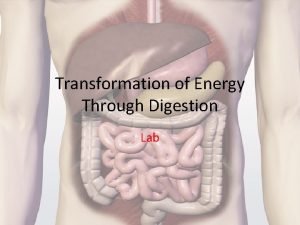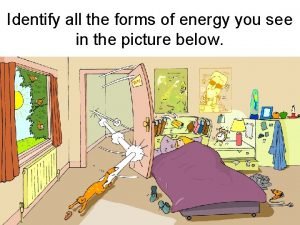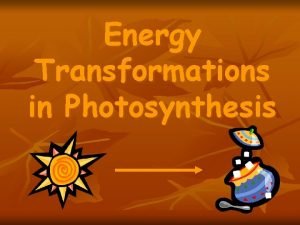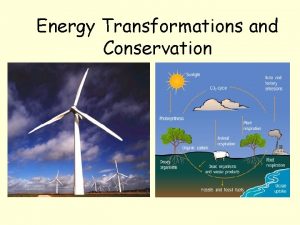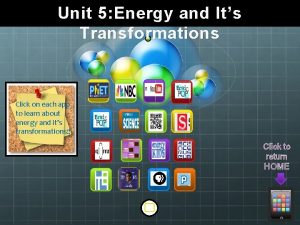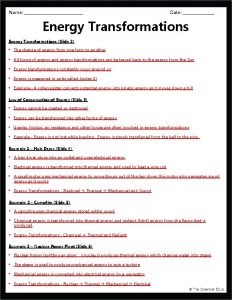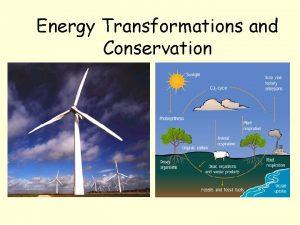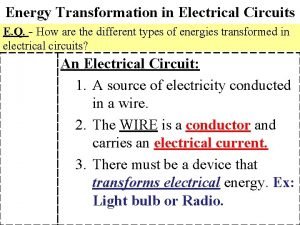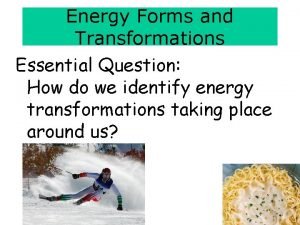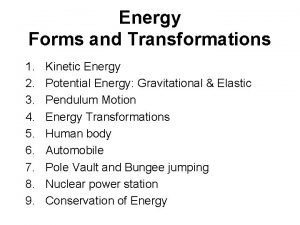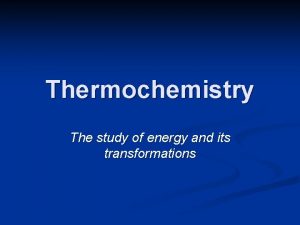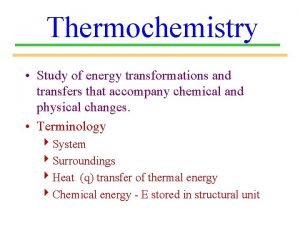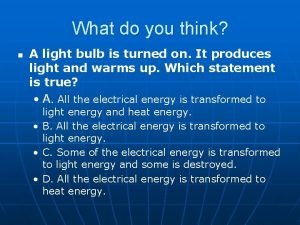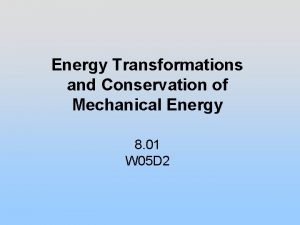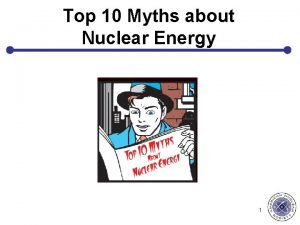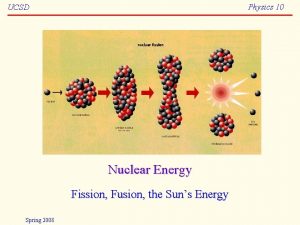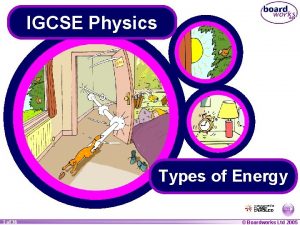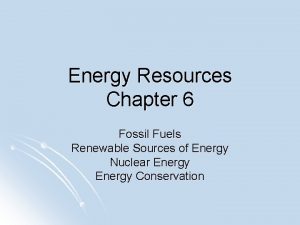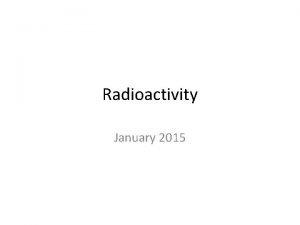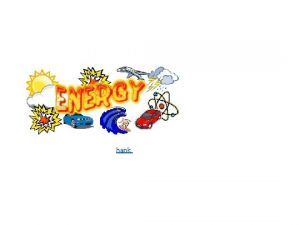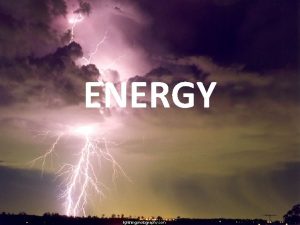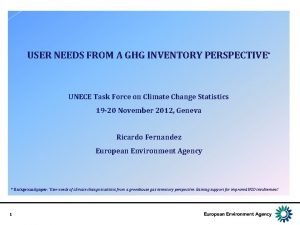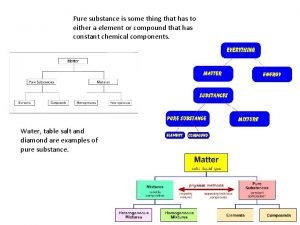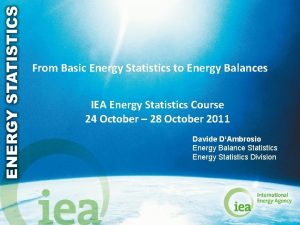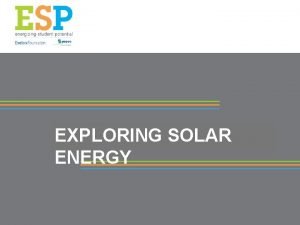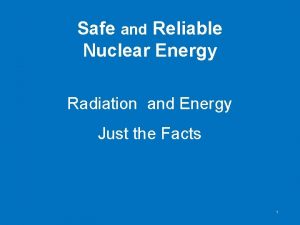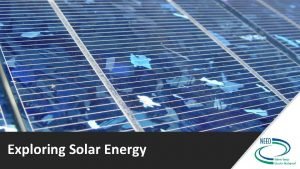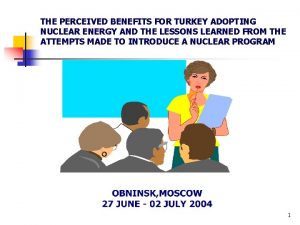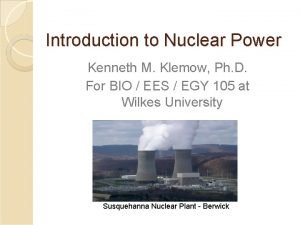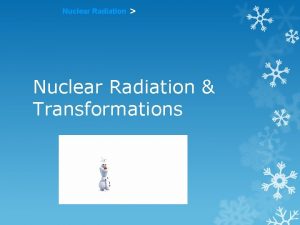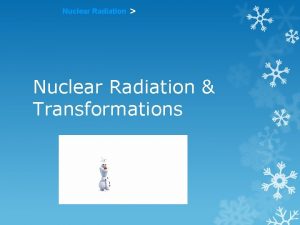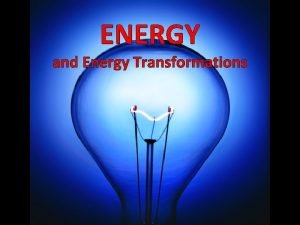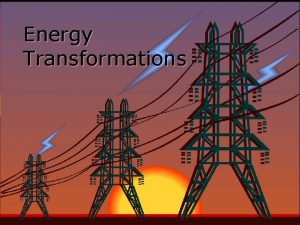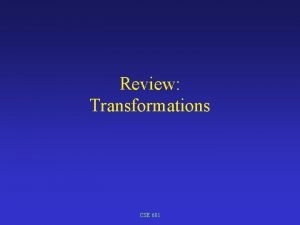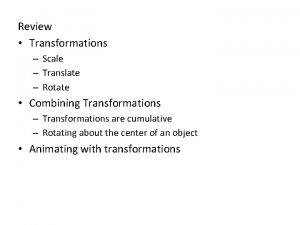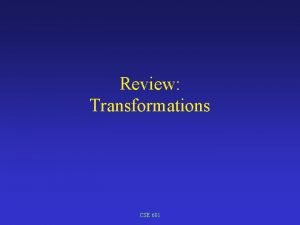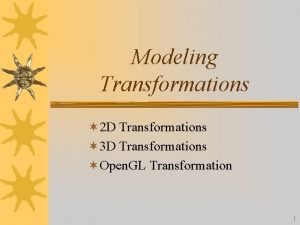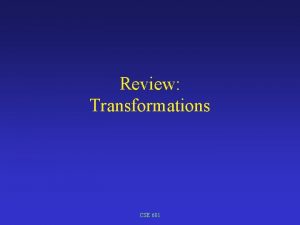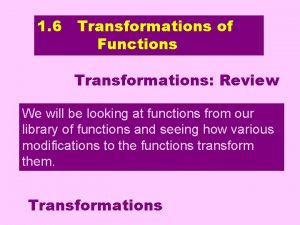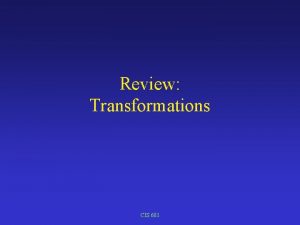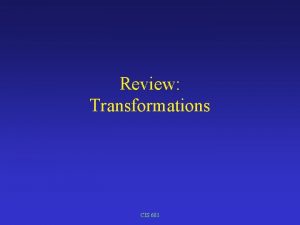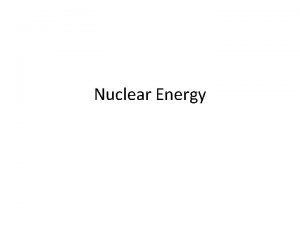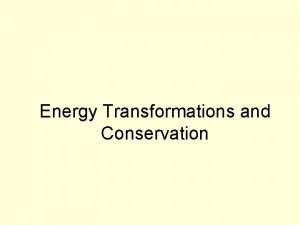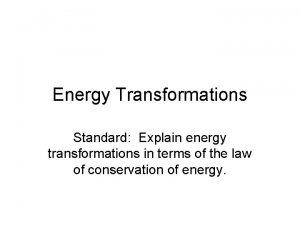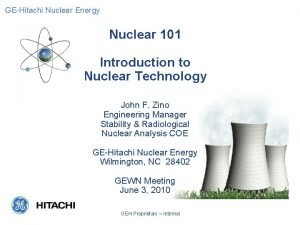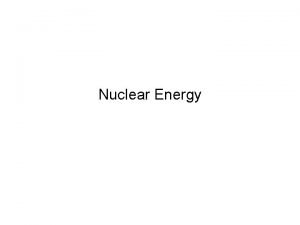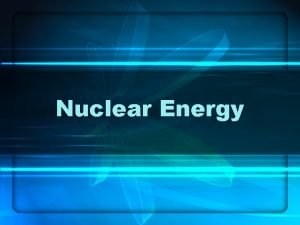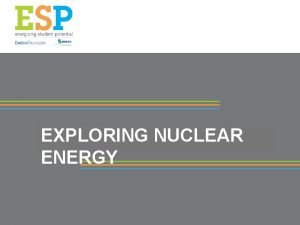Nuclear Energy Recall Recall Energy transformations come in
















































- Slides: 48

Nuclear Energy

Recall:

Recall: • Energy transformations come in two main types

Recall: • Energy transformations come in two main types • Energy type energy type (e. g. kinetic potential)

Recall: • Energy transformations come in two main types • Energy type energy type (e. g. kinetic potential) • Energy Mass

Recall: • Energy transformations come in two main types • Energy type energy type (e. g. kinetic potential) • Mass Energy For the rest of the unit, this is the energy transformation we are referring to

Nuclear energy • Energy transformations come in two main types • Energy type energy type (e. g. kinetic potential) • Mass Energy Nuclear energy, on the other hand, comes from transforming mass into energy

Nuclear energy • Nuclear energy is produced through nuclear reactions

Nuclear energy • Nuclear energy is produced through nuclear reactions • Nuclear reactions are very different from chemical reactions

Nuclear energy • Nuclear energy is produced through nuclear reactions • Nuclear reactions are very different from chemical reactions • Chemical reactions:

Nuclear energy • Nuclear energy is produced through nuclear reactions • Nuclear reactions are very different from chemical reactions • Chemical reactions: • Atoms are rearranged

Nuclear energy • Nuclear energy is produced through nuclear reactions • Nuclear reactions are very different from chemical reactions • Chemical reactions: • Atoms are rearranged • Bonds are broken/formed

Nuclear energy • Nuclear energy is produced through nuclear reactions • Nuclear reactions are very different from chemical reactions • Chemical reactions: • Atoms are rearranged • Bonds are broken/formed • The number and type of atoms at the beginning of the reaction are the same at the end

Nuclear energy •

Nuclear energy •

Nuclear energy •

Nuclear energy •

Nuclear energy •

Nuclear reactions • Nuclear energy can be created through two types of nuclear reactions • Fission • Fusion

Nuclear reactions • Nuclear energy can be created through two types of nuclear reactions • Fission: breaking apart a large atom into several small atoms, releasing energy • Fusion

Nuclear reactions • Nuclear energy can be created through two types of nuclear reactions • Fission: breaking apart a large atom into several small atoms, releasing energy • Fusion: combining two small atoms to form one larger atom, releasing energy

Fission reactions • When a large atom is split into two or more smaller atoms, releasing energy

Fission reactions • When a large atom is split into two or more smaller atoms, releasing energy • Example: Uranium + neutron barium + krypton + 3 neutrons + energy

Uranium + neutron barium + krypton + 3 neutrons + energy

Uranium + neutron barium + krypton + 3 neutrons + energy

Uranium + neutron barium + krypton + 3 neutrons + energy • The mass of reactants (uranium and one neutron) is actually greater than the mass of the products (barium, krypton, and neutrons)

Uranium + neutron barium + krypton + 3 neutrons + energy •

Uranium + neutron barium + krypton + 3 neutrons + energy •

Uranium + neutron barium + krypton + 3 neutrons + energy •

Uranium + neutron barium + krypton + 3 neutrons + energy •

Uranium + neutron barium + krypton + 3 neutrons + energy •

Uranium + neutron barium + krypton + 3 neutrons + energy • This may not seem like a lot of energy but:

Uranium + neutron barium + krypton + 3 neutrons + energy • This may not seem like a lot of energy but: • A 747 requires 720, 000, 000 J of energy

Uranium + neutron barium + krypton + 3 neutrons + energy • This may not seem like a lot of energy but: • A 747 requires 720, 000, 000 J of energy • If we used fission to power the 747 we would only need 8. 7 g of uranium!!!!

Fission reactions • Nuclear power plants use fission reactions to produce electricity Homer saves the day

Fission reactions • Nuclear power plants use fission reactions to produce electricity • Atomic bombs are powered by fission reactions • https: //www. youtube. com/watch? v=Rqy. Bz. XYZPo. M

Fusion reactions • When two small atoms are combined to form one larger atom, releasing energy

Fusion reactions • When two small atoms are combined to form one larger atom • Example: 4 H 2 He + energy

Fusion reactions • When two small atoms are combined to form one larger atom • Example: 4 H 2 He + energy • The mass of the reactants (hydrogen) is greater than the products (helium)

Fusion reactions •

Fusion reactions •

Fusion reactions •

Fusion reactions • Fusion reactions produce about 4 x more energy than fission reactions

Fusion reactions • Fusion reactions produce about 4 x more energy than fission reactions • Fusion reactions power the sun (and therefore the Earth)

Fusion reactions • Fusion reactions produce about 4 x more energy than fission reactions • Fusion reactions power the sun (and therefore the Earth) • We have not been able to harness the power of fusion reactions to produce electricity

Fusion reactions • Fusion reactions produce about 4 x more energy than fission reactions • Fusion reactions power the sun (and therefore the Earth) • We have not been able to harness the power of fusion reactions to produce electricity • Require high temperature and pressure

Fusion reactions • Fusion reactions produce about 4 x more energy than fission reactions • Fusion reactions power the sun (and therefore the Earth) • We have not been able to harness the power of fusion reactions to produce electricity • Require high temperature and pressure • The invention of ‘cold fusion’ would revolutionize energy production

Fusion reactions • Fusion reactions produce about 4 x more energy than fission reactions • Fusion reactions power the sun (and therefore the Earth) • We have not been able to harness the power of fusion reactions to produce electricity • Require high temperature and pressure • The invention of ‘cold fusion’ would revolutionize energy production • H-bombs are powered by fusion reactions (a fission reaction contributes the energy to initiate the fusion reaction) • https: //www. youtube. com/watch? v=qjnm 3 V 0 x. Yj. I
 Come rico come sano
Come rico come sano Lesson 15 nuclear quest nuclear reactions
Lesson 15 nuclear quest nuclear reactions Fisión nuclear vs fision nuclear
Fisión nuclear vs fision nuclear Come holy spirit come inflame our souls with love lyrics
Come holy spirit come inflame our souls with love lyrics Hey come out short story
Hey come out short story Come thou fount come thou king
Come thou fount come thou king Present past and past participle
Present past and past participle Emmanuel son of god
Emmanuel son of god Come mi chiamo come mi chiamo
Come mi chiamo come mi chiamo Come lord jesus come and be born in our hearts
Come lord jesus come and be born in our hearts Softly and tenderly jesus is calling
Softly and tenderly jesus is calling Vorrei essere al mare
Vorrei essere al mare Turn on your radio
Turn on your radio Come mi chiamo come mi chiamo
Come mi chiamo come mi chiamo Beber simple past
Beber simple past Come in come in and sit down
Come in come in and sit down Come in come in and sit down
Come in come in and sit down Energy transformation in digestion
Energy transformation in digestion Car energy transformation
Car energy transformation Radiant energy photosynthesis
Radiant energy photosynthesis Energy transformation running
Energy transformation running Graphic organizer with its energy transformation
Graphic organizer with its energy transformation 7 types of energy
7 types of energy Identify the energy transformations that occur in a guitar
Identify the energy transformations that occur in a guitar Energy transformation and conservation
Energy transformation and conservation Energy transformation in
Energy transformation in Energy forms and transformations
Energy forms and transformations Potential energy in the human body
Potential energy in the human body Study of energy and its transformations
Study of energy and its transformations Study of energy and its transformations
Study of energy and its transformations Energy transformation of a light bulb
Energy transformation of a light bulb Energy transformations definition
Energy transformations definition What are fuels used for
What are fuels used for Nuclear fission
Nuclear fission Is nuclear energy potential or kinetic
Is nuclear energy potential or kinetic Nuclear energy vocabulary
Nuclear energy vocabulary Nuclear energy examples
Nuclear energy examples Bill nye thermal energy
Bill nye thermal energy Work and energy chart
Work and energy chart What are audible and inaudible sounds
What are audible and inaudible sounds Unece nuclear energy
Unece nuclear energy Definition of heat
Definition of heat Unece nuclear energy
Unece nuclear energy Advantages of solar
Advantages of solar Nuclear energy
Nuclear energy Nuclear energy facts
Nuclear energy facts Radiant energy
Radiant energy Nuclear energy
Nuclear energy Uses of nuclear energy
Uses of nuclear energy




